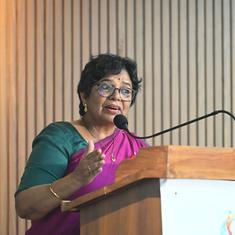Dream Girl is an Urdu film released in July 1986. It appears to have been a complete flop.
The film is worthy of attention for a couple of reasons. It is the product of the vivid and crazy imagination of director Saeed Ali Khan, who achieved in certain circles a cult status not unlike that accorded to John Waters for several of his pictures, most notably the delightfully titled Haseena Atom Bomb (The Beauty Atom Bomb (1990).
Dream Girl is an example of the artist in development. While there is definitely vim and vigour aplenty in this film of a spoiled rich bitch-cum-karate chopping feminist crusader who has a change of heart and in the end uses her dance moves to bring down the heartless villain, Khan has clearly not been able to weave his myriad ideas together in a seamless tapestry. Characters crash into the story unannounced with fully developed backstories while the timeline jumps from present to past without any visible adjustment in the characters’ garb or physical appearance. Atom Bomb was still three or four years away.
The second point of note is that Dream Girl is really a Pashto film. Though the dialogue is entirely in Urdu, the actors are all Pashtuns, including the giant of Frontier filmdom, Badar Munir. The lines are delivered fluently enough but are laced with the charming twang of the borderlands. Given that Pathans are the favorite butts of Pakistani jokes, one wonders at Saeed Ali Khan’s motivation.
But the biggest reason this spectacular clunker is worth a glance is for a couple of brilliant song and dance sequences, the best of which is Main Hun Dream Girl.
Main Hun Dream Girl (I am Dream Girl) is the perfect introduction to what distinguishes Pashto movies from all others: peppy big bodied women in tight outfits creating a general ruckus.
Being the opening and the title track to the movie, the song had to be something special. Run of the mill just wouldn’t do. And so it is. Bubbling with the fuzzy, slightly muddy electronic sound that made 1980s pop music so forgettable, we are treated to a Pakhtun-imagined Midsummer’s Night Dream. Dream Girl (Nadia Hassan) plays Queen Hippolyta decked out in a billowing wedding gown as troops of T-shirt and jeans clad Amazons (hooris, perhaps) dance and frolic in the gardens. Sadly, the groom is nowhere to be seen.
But Dream Girl’s karate teacher, decked out in blue robes, does pop up here and there, calling attention to herself by throwing her hands in the air for no apparent reason and to no effect.
Pashto movies are infamous for their provocative mujras and come hither poses. Dream Girl does not really get into that scene but a repeating series of slinky snapshots of the heroine, which appear to have been manually cut and pasted, do hint at the sex that lies just below the surface. As do the many phallic shaped balloons.
If there are two words that describe this amazing hodgepodge of uninspired choreography (most of the moves imitate marching troops), slow motion gymnastics and general bedlam, they are gay abandon. Everyone is having fun. There are no standards to uphold and no prizes to be won. Kemal Ahmad has come up with a catchy disco sound and a nameless singer croons out the lyrics as the Amazons romp it home and balloons waft in the breeze. There is nothing serious about this and that’s why Dream Girl and Pashto movies, even when they are in Urdu, are so much fun.
A version of this story appeared on the blog https://dailylollyblog.wordpress.com/ and has been reproduced here with permission.










